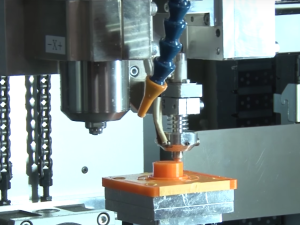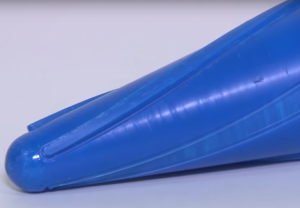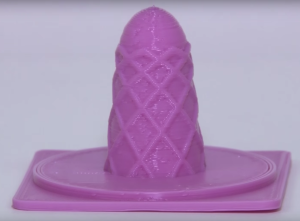
3D printing can start on the z-axis and then rotate to 3D print more complicated geometries, or mill away part of the print.
Japanese tooling and manufacturing equipment developer Enomoto Kogyo is collaborating with Shizuoka University of Art and Culture and software developer C&G Systems to build Japan’s first 5-axis hybrid 3D printer. The printer is capable of continuously performing 3D printing actions as well as milling using existing industrial 5-axis control technology. Traditional extrusion 3D printers have been limited to 3 axes, X, Y and Z, which limits the geometries that are possible without using support material. 5-axis manufacturing equipment is not new technology, and it has been combined with metal 3D printing technology previously. However, combining the precision of a computer-controlled 5-axis industrial machining and tooling system with extrusion-based 3D printing technology will create entirely new additive manufacturing possibilities.
Not only does the ability to combine both additive and subtractive manufacturing to the same device allow for a greater range of complex geometries, but it will cut down on material cost and manufacturing time as well. This feels like an important next step in the development of industrial 3D printers. Currently, 3D printed parts often require supports that need to be manually removed. That adds several additional steps to 3D printing that can slow the process down, and require added manpower. The need to automate as much of the post processing as possible is going to be important as the technology continues to find itself applied to an ever increasing number of industries.
“Conventional [3D] printers are primarily planar lamination printers, but this machine is capable of not only planar lamination, but also 5-axis lamination. Ordinarily, undercutting can’t be performed with 3-axis control type NC, but with 5 axis, tilt and rotation functions are added. In other words, control is implemented for the X, Y, Z, tilt and rotation axis, and as a result, we’re able to print very complex shapes,” explained Enomoto development department chief director Kawamura Takehire.
Computer controlled 5-axis machining platforms have been around for decades, and the technology is the basis of most automated manufacturing systems. While there have been a few attempts to add automation to 3D printers, so far there hasn’t been much success. The problem isn’t typically with the 5-axis technology, but rather the fact that most extrusion technology requires a stable z-axis in order to work. But if the technology developed by Enomoto researchers is sound, then it is likely that we’ll be seeing it adopted by a wide range of industrial 3D printer manufacturers. It could eventually even be scaled down to a desktop size, though that is probably a few years off.
Here is some video of the 5-axis 3D printer in action:
“Our [3D] printer was produced as a machine for use in R&D by professionals rather than everyday users. We want to cultivate a wide-range of various applications and would like to hear from customers about what types of applications they would like to jointly develop, or in other words, what types of items they would like to print with this machine,” Takehire continued.
The benefits of a hybrid 5-axis 3D printer and milling machine like this should be obvious. First, eliminating the need for most support structures will save significant amounts of material, not to mention eliminate the labor required to clean it off. Any support material that may be needed can even be cleaned off by the milling tool on the 5-axis 3D printer itself. It will also reduce equipment costs, as smaller companies can purchase a single machine instead of a traditional 3D printer and a separate milling or CNC machine.
The Enomoto 5-axis 3D printer is especially suited to manufacturing and prototyping prosthetics and assistive devices, medical implants and aircraft or automotive components. So far there has been no indication of the final cost; however, it is expected to be available for purchase around 2017 once the company has evaluated printed samples and verified the technology. Discuss in the Japanese Enomoto 5-axis 3D Printer Collaboration forum over at 3DPB.com.
Subscribe to Our Email Newsletter
Stay up-to-date on all the latest news from the 3D printing industry and receive information and offers from third party vendors.
You May Also Like
Creality Begins Selling HALOT-MAGE S: Setting New Standards in Precision 3D Printing
Creality, a leading innovator in consumer-grade 3D printing technology, proudly introduces the HALOT-MAGE S, the latest breakthrough in high-resolution 3D printing. With its cutting-edge features and user-centric design, the HALOT-MAGE...
Farsoon Showcases Comprehensive 3D Printing Solutions, Automation, and More at TCT Asia
This year’s TCT Asia event showcased just how much the Asian additive manufacturing (AM) market has grown, with Eplus3D’s 64-laser metal 3D printer alone acting as a synecdoche for China’s...
Creality Launches Ender-3 V3 Plus: Bigger CoreXZ for Unprecedented Performance
Embracing a journey of innovation and excellence, Creality’s Ender-3 series has established a distinguished path in the field of 3D printing. From the entry-level Ender-3 V3 SE to the feature-rich...
Laser Wars: Eplus3D Unveils Metal 3D Printer with up to 64 Lasers
Now that the laser wars in the powder bed fusion (PBF) space have, for the most part, moved to China, original equipment manufacturers (OEMs) there are in fierce competition. Eplus3D...



































